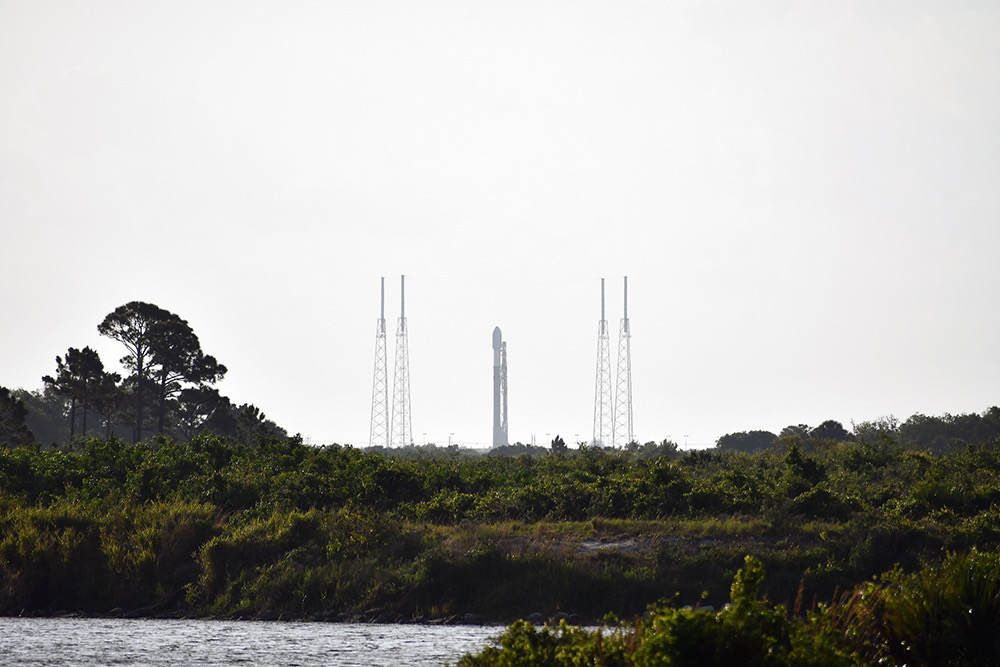Live coverage of the countdown and launch of a SpaceX Falcon 9 rocket from Space Launch Complex 40 at Cape Canaveral Space Force Station in Florida. The Starlink 4-16 mission will launch SpaceX’s next batch of 53 Starlink broadband satellites. Follow us on Twitter.
SFN Live
SpaceX is counting down to launch of a Falcon 9 rocket at 5:27 p.m. EDT (2127 GMT) Friday from Cape Canaveral Space Force Station. A booster that previously flew just 21 days ago will haul 53 more Starlink internet satellites into space.
There is an 80% chance of favorable weather for liftoff Friday on SpaceX’s 151st Falcon 9 mission, and the 43rd flight primarily dedicated to carrying Starlink satellites. The primary weather concern is with cumulus clouds.
The first stage booster — tail number B1062 — will aim for landing on the drone ship “Just Read the Instructions” positioned roughly due east of Charleston, South Carolina, about eight-and-a-half minutes after launch.
SpaceX teams at Cape Canaveral rolled the Falcon 9 rocket from its hangar to pad 40 at Cape Canaveral and raised it vertical early Friday. Beginning at T-minus 35 minutes, the launch team will oversee loading of kerosene and liquid oxygen propellants into the Falcon 9 through an automated, computer-controlled sequencer.
Helium pressurant will also be flowed into the rocket. In the final seven minutes of the countdown, the Falcon 9’s Merlin main engines will be thermally conditioned for flight through a procedure known as “chilldown.” The Falcon 9’s guidance and range safety systems will also be configured for launch at 5:27 p.m.
The 229-foot-tall (70-meter) Falcon 9 rocket will pivot to fly northeast from Cape Canaveral over the Atlantic Ocean.
The rocket will surpass the speed of sound in about one minute, then shut down its nine main engines two-and-a-half minutes after liftoff. The booster will detach, fire pulses from cold gas thrusters, and extend titanium grid fins to help steer the vehicle back into the atmosphere, and use braking burns with its main engines to slow down for landing on the drone ship around 400 miles (650 kilometers) downrange.
This booster is set to launch on its sixth mission, following a debut flight in November 2020 with a GPS navigation satellite, and another GPS launch in June of last year. It flew again Sept. 14 with the all-private Inspiration4 crew mission, and carried a Starlink mission to space Jan. 6, before its most recent flight April 8 on Axiom’s Ax-1 commercial crew mission to the space station.

Continuing the flight into orbit, the Falcon 9’s upper stage engine will shut down nearly nine minutes into the mission, moments after the landing of the first stage downrange in the Atlantic Ocean.
After coasting across the North Atlantic, over Europe and the Middle East, then across the Indian Ocean, the upper stage will reignite its engine for a brief two-second firing to maneuver the 53 Starlink satellites into the proper orbit for separation.
The Falcon 9’s guidance computer aimed to release the flat-panel satellites just shy of one hour after launch in an orbit between 189 miles and 197 miles (304 by 317 kilmeters) above Earth, with an inclination of 53.2 degrees to the equator.
The Starlink satellites will extend solar arrays and use on-board ion thrusters to reach their operational orbit at an altitude of 335 miles (540 kilometers), where they will enter commercial service for SpaceX.
After Thursday’s mission, SpaceX will have launched 2,441 Starlink satellites to date, including spacecraft that were decommissioned or suffered failures. More than 2,100 of those satellites are in orbit and functioning as of Thursday, according to a list maintained by Jonathan McDowell, an astrophysicist who closely tracks spaceflight activity.
Read our mission preview story for more details.
ROCKET: Falcon 9 (B1060.12)
PAYLOAD: 53 Starlink satelllites (Starlink 4-16)
LAUNCH SITE: SLC-40, Cape Canaveral Space Force Station, Florida
LAUNCH DATE: April 29, 2022
LAUNCH TIME: 5:27:10 p.m. EDT (2127:10 GMT)
WEATHER FORECAST: 80% chance of acceptable weather; Low risk of unfavorable conditions for booster recovery
BOOSTER RECOVERY: “Just Read the Instructions” drone ship east of Charleston, South Carolina
LAUNCH AZIMUTH: Northeast
TARGET ORBIT: 189 miles by 197 miles (304 kilometers by 317 kilometers), 53.2 degrees inclination
LAUNCH TIMELINE:
- T+00:00: Liftoff
- T+01:12: Maximum aerodynamic pressure (Max-Q)
- T+02:31: First stage main engine cutoff (MECO)
- T+02:35: Stage separation
- T+02:42: Second stage engine ignition
- T+02:50: Fairing jettison
- T+06:13: First stage entry burn ignition (three engines)
- T+06:32: First stage entry burn cutoff
- T+08:02: First stage landing burn ignition (one engine)
- T+08:24: First stage landing
- T+08:49: Second stage engine cutoff (SECO 1)
- T+45:22: Second stage restart
- T+45:24: Second stage engine cutoff (SECO 2)
- T+59:30: Starlink satellite separation
MISSION STATS:
- 151st launch of a Falcon 9 rocket since 2010
- 159th launch of Falcon rocket family since 2006
- 6th launch of Falcon 9 booster B1062
- 132nd Falcon 9 launch from Florida’s Space Coast
- 85th Falcon 9 launch from pad 40
- 140th launch overall from pad 40
- 94th flight of a reused Falcon 9 booster
- 43rd dedicated Falcon 9 launch with Starlink satellites
- 17th Falcon 9 launch of 2022
- 17th launch by SpaceX in 2022
- 17th orbital launch based out of Cape Canaveral in 2022
Email the author.
Follow Stephen Clark on Twitter: @StephenClark1.
from Spaceflight Now https://ift.tt/wbDUuiF
via World Space Info







0 comments:
Post a Comment